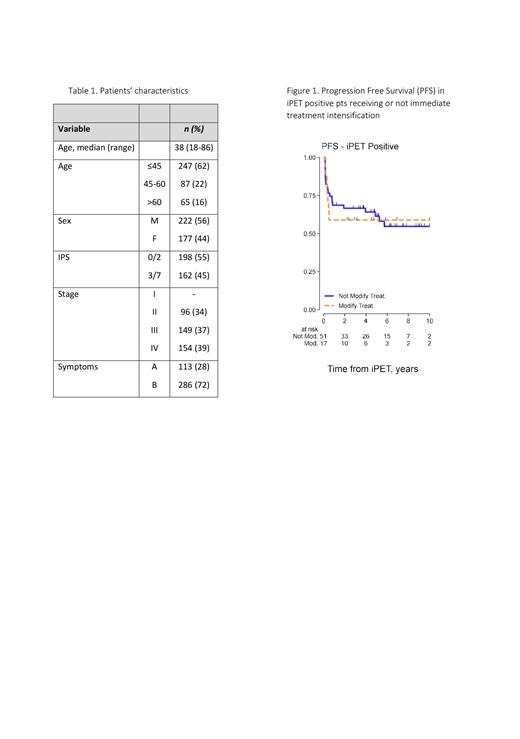INTRODUCTION
Interim PET (iPET) scan after 2 cycles has been proved a useful tool in order to escalate treatment in the setting of advanced stage (AS) classical Hodgkin Lymphoma (cHL) treated with ABVD as first-line therapy. However, few data are known regarding the use of iPET and the adoption of intensification treatment strategies in real life.
MATERIALS AND METHODS
We conducted a retrospective, multicenter study in which we collected consecutive, newly diagnosed AS cHL patients (pts) treated between January 2010 and December 2018. Pts could be included if aged 18 to 80 years old, if treated with ABVD/ABVD-like schemes and if pre-treatment and interim PET scans were available. Primary endpoint was the frequence of intensification after a positive iPET. Secondary endpoints were Progression Free Survival (PFS) and Overall Survival (OS) of pts undergoing iPET-based intensification strategies. iPET was defined as positive or negative based on the assessment by the local investigator. When available, Deauville Score (DS) was also collected. Continuous covariates were summarized as median, interquartile distance (IQR) and range, categorical variables were summarized as absolute and percentage frequencies. Survival functions were defined as the time between the date of iPET to the date of progression (PFS) or death for any cause (PFS/OS) or last clinic control (PFS/OS) for censored cases. The survival functions were computed by means of Kaplan-Meier method. Comparisons between groups were done using the log-rank test; the effect of covariates was estimated using the Cox proportional hazard regression model and was expressed as hazard ratio (HR), with 95%CI. All the p-values reported were two-sided.
RESULTS
Detailed characteristics of the 399 enrolled pts are listed in Table 1. iPET was positive in 68 pts (17%), of whom 17 (25%) were immediately shifted to intensified therapies: 8 escBEACOPP (eB), 8 chemo+ASCT (cA), 1 other salvage regimens (oSR). DS was reported in 220 (55%) pts. In iPET-positive pts, DS was reported in 35/68 pts (51,4%): 25 were DS4 and 10 were DS5, respectively. Among the 51 iPET positive pts who didn't change treatment after iPET, 31 (61%) underwent a subsequent iPET after 4 cycles. iPET4 was positive in 17 pts (55%), of whom 12 (70%) were shifted to intensified treatments: 2 eB, 8 cA, 2 oSR. Overall, 29/68 iPET-positive pts (43%) were intensified either immediately after iPET or after a subsequent iPET4 positivity and the most commonly used intensification was cA (16/29 cases). After a median follow up of 6 years (0.2 - 12), 5-y PFS was 76% (95% CI 72 to 80%), and 5-y OS was 94% (95% CI 91 to 96%). In univariable analysis, iPET positivity (5y PFS 60% versus 80% for iPET negative pts, p < 0.001), stage IV, age (continuous form) and not receiving radiotherapy were significantly associated with worse PFS; iPET positivity (5y OS 82% versus 96% in iPET-negative pts, p=0.003), stage IV, age ≥ 60, IPS, B symptoms, male gender and not receiving radiotherapy were significantly associated with worse OS. PFS and OS were similar (p=0.851 and 0.520, respectively) for iPET-positive pts undergoing or not undergoing immediate intensification (59% versus 61%, and 84% versus 81%, respectively) [Figure 1]. The 5-y PFS and OS were significantly different between pts with iPET negativity and iPET positivity, as reported above. Remarkably, among iPET+ pts, no treatment modification after iPET positivity (either after 2 or 4 cycles) was associated with worse 5-Y PFS and OS (72% and 82% respectively) if compared to PET negative pts. Moreover, there were no differences in terms of both PFS and OS for iPET pts who modified treatment after either iPET or iPET4.
CONCLUSIONS
In AS cHL pts undergoing ABVD first line treatment, iPET positivity is 17%, but few pts shifted to intensification strategies and most pts didn't change treatment and underwent to iPET4. iPET4 was positive in 17/31 pts, of whom 70% shifted to salvage treatments, mainly cA. iPET prognostic role was confirmed, since PFS and OS were strongly correlated with iPET status, but early intensification didn't provide any PFS and/or OS advantages. Due to the high prognostic role of iPET positivity, AS cHL pts might benefit from more intensive first line treatments that could reduce iPET positive cases (e.g. AVD combos with anti-PD1 or brentuximab vedotin) or from more efficacious second line therapies (e.g. Brentuximab Vedotin and/or anti-PD1 based combination strategies)
Disclosures
Zilioli:Servier: Speakers Bureau; Lilly: Speakers Bureau; Incyte: Speakers Bureau; Janssen: Other: travel expenses, Speakers Bureau; Takeda: Membership on an entity's Board of Directors or advisory committees, Other: travel expenses, Speakers Bureau; Gilead: Membership on an entity's Board of Directors or advisory committees, Research Funding; MSD: Membership on an entity's Board of Directors or advisory committees, Research Funding; Novartis: Membership on an entity's Board of Directors or advisory committees; Roche: Consultancy, Other: travel expenses. Luminari:Incute: Membership on an entity's Board of Directors or advisory committees; Jannsen: Membership on an entity's Board of Directors or advisory committees; ROCHE: Membership on an entity's Board of Directors or advisory committees; Regeneron: Membership on an entity's Board of Directors or advisory committees, Speakers Bureau; BMS: Membership on an entity's Board of Directors or advisory committees, Speakers Bureau; Beigene: Membership on an entity's Board of Directors or advisory committees.


